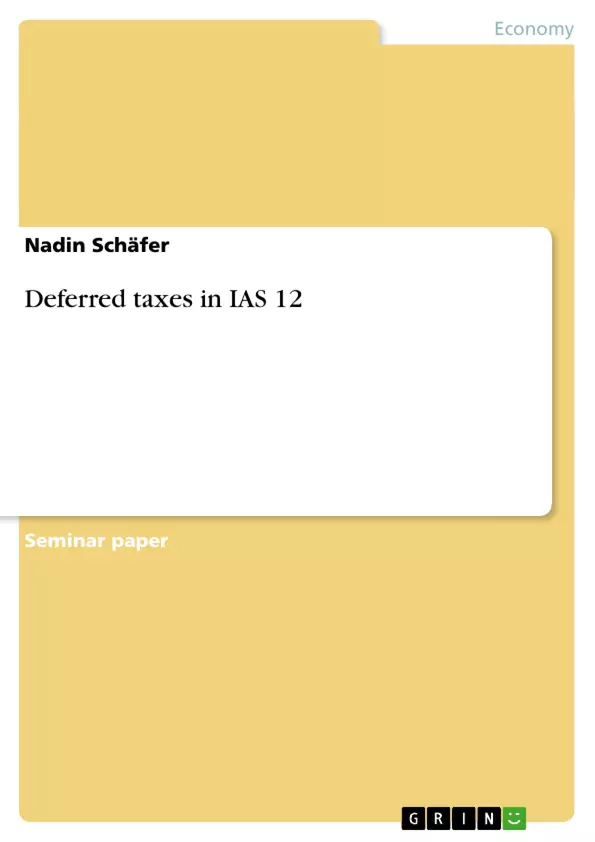By writing this report I would like to introduce the reader into the topic of deferred taxes by using the International Accounting Standard 12. Therefore I would like to introduce you into the topic deferred taxes by giving you the theoretical basic concept of deferred taxes. The theoretical basic concept of deferred taxes should give you the idea and a definition of deferred taxes. Afterwards I would like to present the different causes for creating deferred taxes. The causes for creating deferred taxes will be emphasized by give examples. For a better understanding I would like to explain in the following the steps the methods of determination. You have to know that the IAS determines the deferred taxes by using the temporary concept. Because I would like to underline the differences I will present in short form the timing concept too. The temporary concept includes the timing and the temporary differences and excludes the permanent differences. Now we have to find a definition for each type of difference. If we know the idea of deferred taxes and we know how to determine them, we will be interested in the evaluation of deferred taxes. Therefore I will describe the liability method used by IAS and to show the differences I will describe the deferred method. For a better understanding I would like to conclude my report by giving the different way of calculation deferred taxes by using the deferred method and the liability method.
Inhaltsverzeichnis (Table of Contents)
- 1. Theoretical basic concept for deferred taxes
- 2. Causes for deferred taxes
- 3. Methods of Determination
- 4. Types of differences
- 4.1 permanent differences
- 4.2 Temporary differences
- 4.3 Timing differences
- 5. Evaluation Method
- 5.1 Liability method
- 5.2 Deferred method
- 5.3 Comparison of calculation of deferred taxes by using the deferred-method and by using the liability method
- 5.3.1 Explanation of the first period: deferred method
- 5.3.3 Accounting records for deferred method and liability method
Zielsetzung und Themenschwerpunkte (Objectives and Key Themes)
This report aims to provide a comprehensive overview of deferred taxes within the context of International Accounting Standard 12 (IAS 12). The report will delve into the theoretical foundation of deferred taxes, explore the various causes for their emergence, and explain the methods of determining deferred taxes.
- Theoretical framework of deferred taxes
- Causes and origins of deferred taxes
- Methods for determining deferred taxes
- Types of differences: temporary, permanent, and timing
- Evaluation methods: liability and deferred methods
Zusammenfassung der Kapitel (Chapter Summaries)
The report begins by establishing a clear understanding of the theoretical basis of deferred taxes, providing a fundamental definition and explanation of the concept. It then delves into the diverse factors that contribute to the generation of deferred taxes, offering illustrative examples for clarity. To enhance comprehension, the report meticulously outlines the steps involved in determining deferred taxes, emphasizing the temporary concept employed by IAS 12. To highlight the distinctions, a concise overview of the timing concept is also presented. The report proceeds to define each type of difference: temporary, permanent, and timing.
The report then explores the evaluation of deferred taxes, explaining the liability method used by IAS 12 and contrasting it with the deferred method. The report concludes by providing a comparative analysis of calculating deferred taxes using both the deferred method and the liability method, ultimately presenting a comprehensive understanding of this crucial aspect of accounting.
Schlüsselwörter (Keywords)
The primary keywords and focus topics of this report revolve around deferred taxes, IAS 12, temporary and permanent differences, timing differences, liability method, and deferred method. The report explores the theoretical basis of deferred taxes, analyzes their causes, and examines the methods of determining and evaluating these taxes within the framework of IAS 12.
- Citation du texte
- Nadin Schäfer (Auteur), 2005, Deferred taxes in IAS 12, Munich, GRIN Verlag, https://www.grin.com/document/48204



